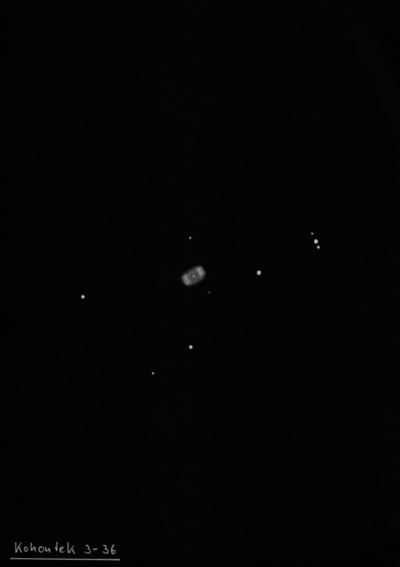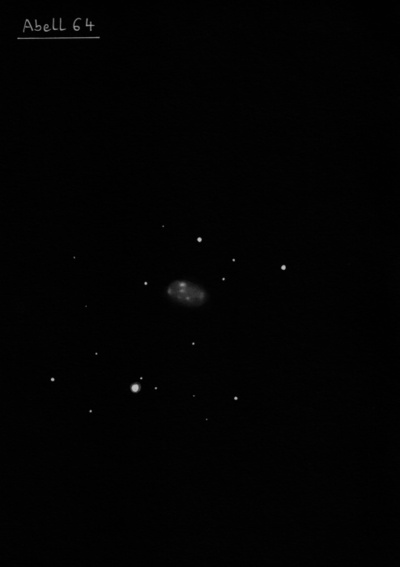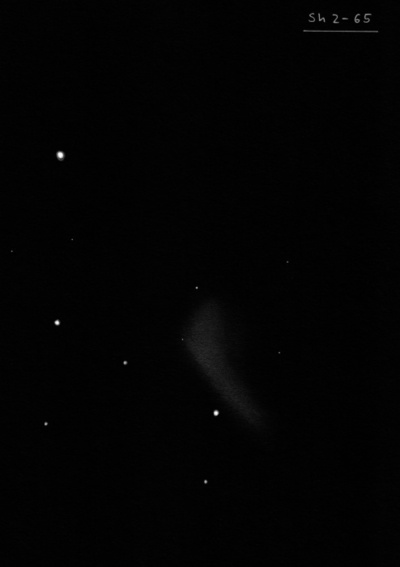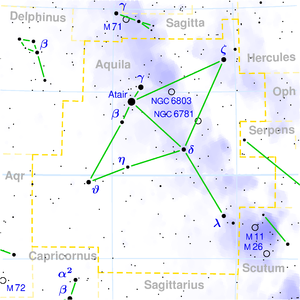
The prominent constellation traversing the celestial equator, divided into two parts by the Great Rift within the Milky Way, lies in the southern sky beneath Cygnus, Sagitta, and Vulpecula. The northern and western sections of the constellation are rich in stars, some areas overlaid by dark clouds of gas and dust, making it a popular stroll for observers with binoculars on summer nights. The brightest star, shining with a blue-white light, is Altair, forming the Summer Triangle with Vega in Lyra and Deneb in Cygnus. The constellation lacks any prominent deep-sky objects, but it hosts numerous fainter and smaller planetary and dark nebulae, with the most famous being the Dark Rift in Aquila. This exceptionally dark dust cloud is found about one and a half degrees from Gamma Aquilae, with its northern part designated as Barnard 143 in atlases, and the southern part represented by Barnard 142. When viewed through binoculars, they appear as starless areas forming the shape of the letter "E," creating a strong impression of opaque material between the observer and distant stars.
The Milky Way in Aquila visually gives the impression of being threaded with gas and dust clouds from the Great Rift, not equally bright everywhere. It contains star clouds, noticeable patches of randomly scattered faint stars, and dark nebulae cutting into and shaping its form. The first slight brightening occurs in the main stream east of the star 23 Aquilae, roughly where the Milky Way intersects the celestial equator. West of Altair, a bright elongated band emerges, extending into the Sagitta constellation. About two-thirds of the distance from the top, another brightening appears, along with a circular (but less noticeable) one west of the star Mu Aquilae.
During summer nights, if you take a stroll with binoculars along the Milky Way, you may be surprised that in the extensive and otherwise prominent constellation of Aquila, you will find practically no interesting open star clusters. This part of the sky consists mainly of the region between Orion's arm and Sagittarius, with very close or, conversely, very distant and faint stars that reliably obscure the dark clouds of the Great Rift, a complex of dust in our arm along the galactic equator. The narrowest section, with sharp borders, is in Cygnus, while the widest is between Aquila and Ophiuchus, slightly veering westward. At this point, it is much closer to us—only 1,500 light-years—while in Cygnus, it extends to thousands of light-years. As the chain of dark nebulae is slightly inclined to the plane of our galaxy, the Milky Way is brighter in the southeast of the Great Rift in Aquila, while in Cygnus, it is in the northwest.
Altair (α Aquilae) - one of the closest bright stars visible to the naked eye. It has a magnitude of 0.77 and is approximately 16.5 light-years away from us. It is only 11 times brighter and has a diameter one and a half times larger than our Sun. Altair is also an optical double star, with a companion of magnitude 10 located at a distance of 165 arcseconds, still visible with an 8 cm telescope.
η Aquilae - The brightest Cepheid on the sky, located 1,000 light-years away, lies 8 degrees south of Altair. The changes in brightness of this giant star can be easily observed with the naked eye. Its brightness fluctuates regularly between 3.7 mag and 4.4 mag over a period of 7 days and 4 hours. It is advisable to compare the changes in its brightness with the stars θ, δ (3 mag), and λ (4 mag).
π Aquilae - A pair of beautiful yellow stars (6.1mag and 6.9mag) with a separation of 1.4" can already be seen with a 10 cm telescope. Although at 150x magnification they are still in contact with each other.
R Aquilae - A variable star of the Mira type, located in the Milky Way, 5.5 degrees south of the star ζ Aquilae. Since the beginning of the 20th century, the period of brightness changes of this red giant has shortened by about 66 days. At the beginning of the 20th century, the period lasted approximately 350 days. Currently, the brightness changes from 5.5mag to 11.5mag in 284 days.
N 1918 Aql - After the nova, which appeared in the Aquila constellation in 389 and became brighter like Venus, astronomers witnessed another one in 1918. It became the brightest star in the constellation and the second brightest star in the sky, reaching -1.1 magnitude. Today, it cannot be observed with the naked eye or even with a telescope, as it only reaches 10.8 magnitude.
NGC 6709
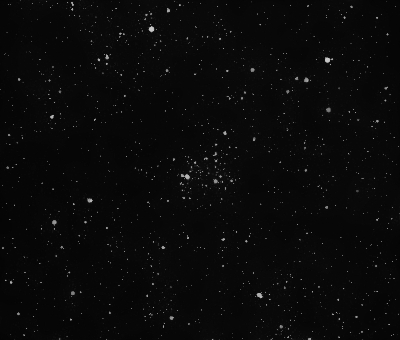
John Herschel discovered NGC 6709 = h2020 on 29 Jul 1827 and recorded "a p considerable cl; 15' diam; irreg fig, 50 or 60 stars, large and scattered. The place is that of the double star No. 870 [HJ 870] of my third catalogue." His position is accurate.
300/350mm - 13" fairly large, about 70 stars in cluster, includes some close double stars.
400/500mm - 17.5" (8/1/86): over 100 stars mag 9-14 resolved in a 15-20' field but not dense. Appears best at 83x-105x. An easy mag 10 double star at 22" separation is at the east side and a close fainter pair follows. Visible in 16x80 finder.
Notes by Steve Gottlieb
NGC 6781
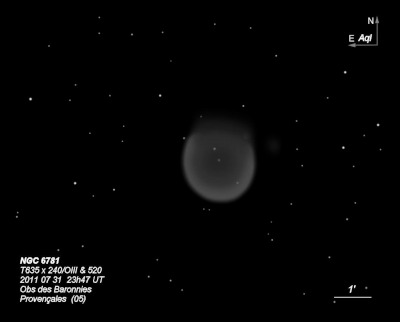
William Herschel discovered NGC 6781 = H III-743 = h2037 on 30 Jul 1788 (sweep 850) and recorded "cF, irregularly round, 3 or 4' diam, resolvable." John Herschel made a detailed observation on 15 Aug 1830 (sweep 280): "A most beautiful, vL, F planetary nebula. Diameter in RA = 6.5 seconds = 1' 37"; its light nearly uniform, only very little hazy at the edge and perhaps rather brighter at the southern limb. It nature seems to have been overlooked or mistaken by my Father, who has placed it in his third class [Very Faint Nebula]. In Milky Way. Many stars in field, one 11m near the north-following limb." On 28 Aug 1850, Lord Rosse (or assistant) described the planetary as "annular or perhaps spiral, star distinctly seen in dark part n of centre, others seen at moments. The dark space is undoubtedly irr in form."
Johann von Lamont made a sketch on 7 Jul 1837 with the 11" Merz refractor at the Munich Observatory. William Lassell observed the planetary on Malta with his 48" reflector and made a sketch on 29 Aug 1862. Another sketch was made around 1877 by Wilhelm Tempel with the 11" refractor at Arcetri Observatory in Florence. Temple compared his results with Lamont and Lassell. E.E. Barnard described the planetary as annular using the Yerkes 40" refractor in 1899.
Based on Crossley photographs at Lick, Curtis (1918) reported "this object is `06" in diameter from east to west, and a little longer than this along a major axis in approximately p.a. 5°. Exceedingly faint at the north; brightest at east and west edges, and fainter along the major axis. Indistinct ring structure shown around edges."
200/250mm - 8" (7/24/82): large and easily viewed but the annularity was not seen with any certainty.
300/350mm - 13.1" (6/29/84): the rim is brighter mainly on the SW side giving a slightly annular appearance. A faint star is off the east edge.
13.1" (8/15/82): brighter rim mostly evident on the south side and a darker center just visible at 140x-200x.
400/500mm - 17.5" (6/30/00): at 220x unfiltered this fairly bright PN has a 1.5' round halo. The rim is brightest and more well-defined along an arc on the south and southeast rim. The central 45" hole is slightly darker and irregular in surface brightness. A mag 13 star is at the northeast edge and once or twice I caught a fainter glimmer of an interior star north of center.
17.5" (7/12/99): at 100x appears fairly bright, round, ~1.6' diameter with a darker center. I used a variety of magnifications and filters but the most interesting view was at 220x using a UHC filter. With this combination the PN is slightly elongated E-W and clearly brighter along the southern rim with the brightening tapering towards the ends so this brighter portion had a crescent appearance. Because of this asymmetric rim the darker center seems offset and only weakly brightens at the NW rim. A mag 13 star is just off the NE edge 1' from center.
17.5" (8/2/86): at 222x and UHC filter; very large, about 1.8' diameter, much brighter on the SW portion of the rim, darker center. A mag 13 star is just off the NE edge.
600/800mm - 24" (6/30/16): at 322x and 500x; fairly bright and large, round, just under 2' diameter. Contains a relatively thick, much brighter rim, except on the north side. The annulus is unevenly in surface brightness, but brighter along a 180° arc, centered on the side south and dimming gradually but extending ~240°. This gives the planetary a "C" shape appearance. The remaining 120° arc, centered on the north edge, is noticeably fainter. A mag ~13.5 star is at the northeast edge, a mag ~14.5 star is just off the north-northwest edge and a mag 15.5+ star is barely off the south edge. An extremely faint star is superimposed just north-northeast of center (probably not the central star).
Notes by Steve Gottlieb
NGC 6755
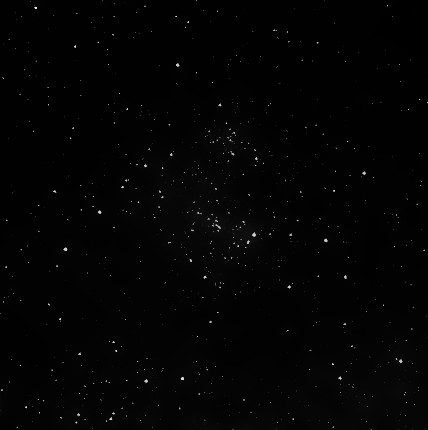
William Herschel discovered NGC 6755 = H VII-19 = h2030 on 30 Jul 1785 (sweep 416) and recorded "a pretty compressed cluster of pS scattered stars, of various magnitudes and colour, 12 or 15' diameter. On 21 Aug 1791 (sweep 1017), he recorded "a cl of stars of various sizes, considerably rich, the condensed part of it is divided in two." On 13 Aug 1830, JH described a "vL, v rich cluster, composed of 2 or 3 clustering groups running together; place that of the most condensed part." His position matches the richest part of the cluster.
200/250mm - 8" (8/28/81): large, scattered, two parts are resolved into rich clumps.
400/500mm - 17.5" (8/8/91): at 140x this is a bright group of 80 stars mag 10-14 in a 10' diameter. The stars are arranged in two groups separated by a fairly wide, obvious dark rift oriented SW-NE. The southern star group is larger and richer (about 50 stars) and contains several stars in two rich subgroups. The northern group is also catalogued as Czernik 39. A mag 10 star is at the west edge of the northern group. NGC 6756 lies 30' NE.
600/800mm - 24" (8/27/14): although the listed diameter is 15', the most eye-catching region extends only 5' and is described as the southern group in the earlier observation. The stars are arrange in two main groups. On the west side is a "U" shaped group of a dozen stars, open to the northwest, with the brightest mag 10.3 star at the southwest end of the loop. A nice unequal pair (~12" separation) is ~40" SE. Another couple of pairs (one very close) is along the east side of the loop. A smaller (~2' dia) but richer group of a dozen stars is 2'-3' NE. A long looping string of ~20 stars, including two 10th magnitude, begins close southeast of this group and curves to the south and west, ending in a small knot of 4 stars. The region between this loop and the two groups described above contains 10-12 mag 15 stars.
Notes by Steve Gottlieb
NGC 6760
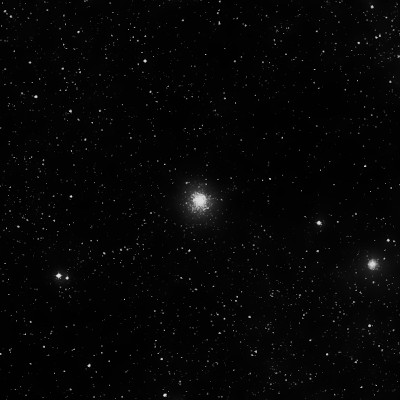
John Russell Hind discovered NGC 6760 = Au 44 on 30 Mar 1845 using a 7-inch Dollond refractor, while employed at George Bishop's private observatory in London. He reported "On the night of 1845 March 30, I found a faint nebula of a circular form... There does not appear to be any previous notice of this nebula, and Sir James South informs me that he can find no registered nebula within two degrees of this place. This somewhat singular as the present object was found while searching for comets with our 11 foot refractor."
Heinrich d'Arrest independently discovered the cluster in 1852 (announced in AN 809) while searching for comets with the 4.6-inch Fraunhofer refractor in Leipzig, though he later corrected his announcement. Arthur Auwers reported that in the 6" Heliometer it was "quite bright, R, gbM, 2-3' diameter." but once it was "surprisingly faint." At Birr Castle, Dreyer reported it as "vB, L, iR, vgpmbM, like a distant glob. Cl, although not distinctly resolved with the higher powers. eF curved branches go out from the south side."
John Herschel noted in the General Catalogue that this nebula was suspected of variability due to the widely disparate visual brightness estimates. A photograph was taken with the Mount Wilson 60-inch in 1914 due to comments about variability and the cluster was resolved into "1200 stars ranging approximately from 16.5 to 19.5 photographic magnitude...No trace of nebulosity is found."
200/250mm - 8" (6/22/81): faint, small, no resolution, very diffuse.
400/500mm - 17.5" (8/8/91): moderately bright, round, 3' diameter slightly elongated E-W, very mottled or granular appearance. A few very faint stars are resolved over the core and at the edge of the core. With averted vision the faint halo increases in size to 4' diameter. Several stars bracket the halo including a mag 13.5 star off the east edge. A rich mostly unresolved clump of extremely faint stars is close west.
600/800mm - 24" (8/12/15): viewed at 564x in excellent seeing and I was impressed with the resolution compared to previous views. The 2' core was extremely mottled and lively with roughly two dozen very faint stars popping in and out of view, but only a relative few constantly visible. Another couple of dozen stars were resolved in the halo, mostly in a 180° arc along the entire southern side. The stars along this arc are confined to a fairly thin strip that appeared detached from the core. Also a sparse string of stars extends northeast of the core.
Notes by Steve Gottlieb
NGC 6751
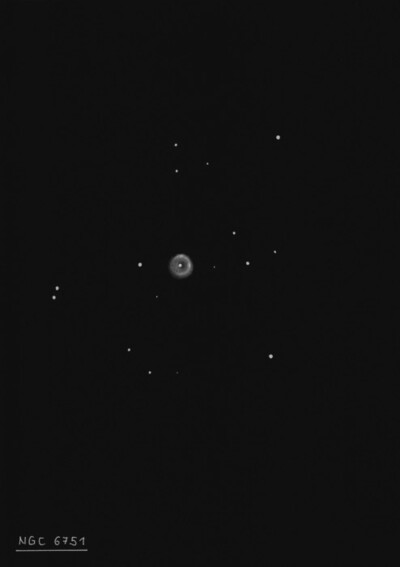
Albert Marth discovered NGC 6751 = m 397 = St XII-90 on 20 Jul 1863 using Lassell's 48-inch equatorial reflector on Malta and noted "pB, S." His position is 2' too far south. Édouard Stephan found it on 17 Jul 1871 and logged St II-26 (later NGC 6748) as "bright, small, round, central condensation, seems resolvable." He misidentified his reference star, though, and NGC 6748 was lost onto 2016 when Harold Corwin noticed the offsets for an observation of NGC 6751 given in Esmiol's re-reduction matched Stephan's computed offsets for NGC 6748. So, NGC 6748 = NGC 6751. Stephan made a second observation (St XII-90) of NGC 6751 on 3 Aug 1881 and measured an accurate micrometric position. In the notes section to list XII, he mentions a 2' error in Marth's polar distance, so he was aware of the prior discovery. Williamina Fleming first recognized it as a planetary nebula in 1907.
Based on Crossley photographs at Lick, Curtis (1918) reported "central star about mag 12. The nebular disk is 21" in diameter, nearly round, and shows indistinct evidences of a very irregular ring formation."
300/350mm - 13.1" (8/16/81): fairly faint, small, round. The mag 15 central star is suspected at high power. A mag 13.5 star is right at the east edge and a mag 12.5 is 55" ESE of center. Located 30' SE of the striking deep red variable V Aquilae (6.6-8.4).
400/500mm - 17.5" (6/3/00): fairly faint, small, round, 20" diameter. At 500x, the surface brightness is uneven and the planetary appears darker on the SE side of the center. The mag 14.5 central star is obvious at 500x. Two stars just off the east and west edge (fainter star is at the preceding side) bracket the planetary. Situated in a rich Milky Way star field.
600/800mm - 24" (9/30/16): symmetric, very attractive planetary at 450x (unfiltered). The edge of the 20" rim is crisply defined. The mag 14.5 central star is easily visible. Annularity is evident with a brighter rim except for a section of the south edge. The center is slightly darker around the central star. In a rich star field with carbon star V Aql 30' NW.
Notes by Steve Gottlieb
NGC 6804
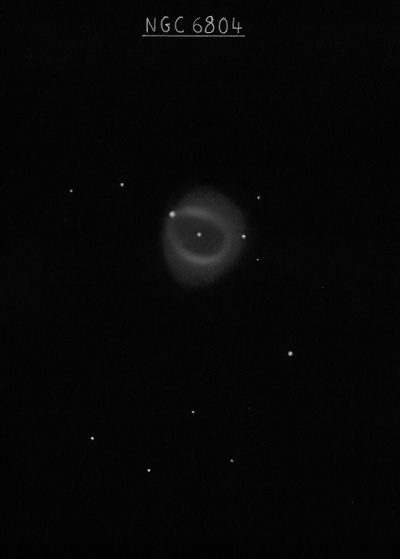
William Herschel discovered NGC 6804 = H VI-38 = h2043 on 25 Aug 1791 (sweep 1018) and recorded "cB, S, iF, easily resolvable. Some of the stars visible." He mistakenly placed this planetary nebula in classification class VI of "Very compressed and rich clusters of stars." John Herschel also assumed it was a cluster, though on his first of four observations (21 Aug 1827), he logged "doubtful if a resolved cl or a neb of first class. pL; R; bM; 60"; with 2 or 3 accidental stars of the Milky Way." Confirmed as a planetary by Francis Pease in 1917.
Based on Crossley photographs at Lick, Curtis (1918) wrote, "an irregular ring 33" from north to south and 30" from E to W; brightest on north and south and fades out along an axis in p.a. 48°. The oval disk of much fainter matter outside is 63"x50" in p.a. 0°, and stronger at western and southern edges."
300/350mm - 13" (8/5/83): moderately bright, elongated WSW-ENE. Unusual appearance as four faint stars are very near or involved including the faint mag 14 central star visible with averted vision. A mag 13 star is at the NE edge 27" from the center, a very faint mag 15 star is at west edge and a similar star is just NW. The rim is possibly slightly brighter on the east edge.
400/500mm - 17.5" (7/11/99): at lower powers appears moderately bright, irregularly round, ~1' diameter with several stars involved or nearby. At 280x, the view is very unusual with three stars involved and others nearby. The brightest is a mag 12.5-13 star at the NE edge. The mag 14 central star is visible with direct vision. Finally, a mag 14.5-15 star is at or just off the west side. The planetary is slightly elongated 4:3 SW-NE with an irregular surface brightness. The rim appears brighter along the east and northeast side and weakest at the west edge. Nearby stars include a mag 13 star ~1.5' NE (nearly on a line with the central star and the star on the northeast edge) and a mag 15-15.5 star close south-southwest of the star at the west edge.
600/800mm - 24" (6/30/16): at 501x (unfiltered): bright, irregular planetary with interesting structure! The overall shape is roughly oval, extending WSW-ENE, ~0.7'x0.5'. The 14th magnitude central star is very easy. A brighter mag 12.5-13 star is along the rim on the northeast side and a fainter mag 14-14.5 star is at the west edge of the rim. The latter star has a mag 15-15.5 companion 12" SSW. Also a 10" pair of mag 14/15 stars is off the northeast side. The rim is brightest along thin 90° strips centered on the southeast and northwest side and weak or open on the southwest side. Along with the brighter star on the northeast end, this creates a "C" or horseshoe appearance with a darker center.
Notes by Steve Gottlieb
NGC 6772
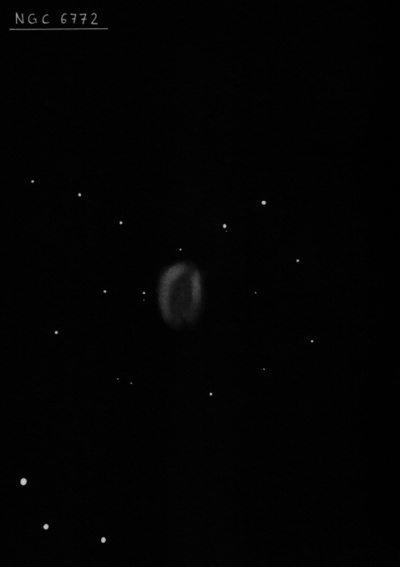
William Herschel discovered NGC 6772 = H IV-14 = h2032 on 21 Jul 1784 (sweep 242) and recorded "vF, r, nearly of equal light throughout; about 1' in diam. In the midst of numberless stars of the milky way." His position was 7' too far west-northwest. On 23 Jul 1827, JH noted "vF; R; vlbM; r; 30"." His position (also measured the next sweep) is fairly accurate.
Based on Crossley photographs at Lick, Curtis (1918) reported "the nebula is a a very faint and vague oval ring 75"x56" in p.a. about 173°. Brightest on the east and west edges; considerably fainter along and at the ends of the major axis."
200/250mm - 8" (7/31/81): faint, diffuse, moderately large.
300/350mm - 13.1" (8/8/86): moderately bright, slightly elongated N-S, estimate V = 13.0. Pretty view at 214x and UHC filter with a slightly mottled or uneven surface brightness.
400/500mm - 17.5" (9/5/99): easily picked up at 100x as a 1' disc, appearing slightly irregular. Best view at 220x and 280x using a UHC filter. The disc was quite irregular in surface brightness and slightly elongated N-S. Most notably, the rim is generally brighter along the northern side in a broad "U" shape with the center weakly annular. The south rim of the planetary is fainter and less well defined. No central star seen at 380x.
600/800mm - 24" (8/30/16): at 225x and 375x (unfiltered); moderately bright and large, slightly elongated ~N-S, ~70"x55". The rim is slightly brighter, particularly along the east and west side and weaker on the south end. The surface brightness is irregular or mottled and there appeared to be a small knot [the DSS reveals two faint, very close stars] embedded on the northeast side. A mag 15.7 star is just off the east side [44" from center] and a mag 16.3 star is just off the north end [52" from center].
Notes by Steve Gottlieb
NGC 6741
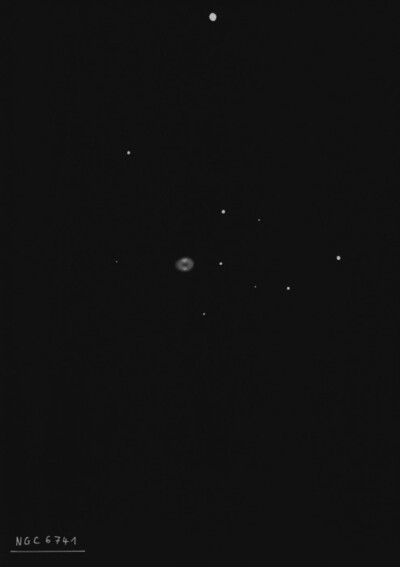
Edward Pickering discovered NGC 6741 on 19 Aug 1882 using a direct-vision spectroscope with the 15-inch refractor at Harvard College Observatory. The discovery was announced in AN 2459 and The Observatory, Vol 5, for Oct 1882.
Robert Jonckheere mistakenly catalogued this object as a double star (J 475) in 1911, based on observations with the 14-inch equatorial refractor at the University of Lille. The following year he reobserved it with the 28-inch Greenwich refractor and realized it was nebulous and identical to the planetary NGC 6741 (see http://articles.adsabs.harvard.edu/cgi-bin/nph-iarticle_query?1915Obs....38..478J).
Based on Crossley photographs at Lick, Curtis (1918) reported "No central star. A small bright oval, 9"x7" in p.a. 95°. It shows traces of an indistinct ring structure, being somewhat fainter along the major axis. There is a small, scarcely perceptible protuberance at the western end."
John Mallas coined the nickname "Phantom Streak" in his Jun/Jul 1963 article "Visual Atlas of Planetary Nebula-V", published in the "Review of Popular Astronomy". He writes: The "Phantom Streak." First you see it and then you don't...In the 4-inch looks like a broad silver line. Almost uniform in brightness, the ends appear broken and diffused...My visual impression agrees with H.D. Curtis's description of this object. He states "It shows some trace of a ring structure, being somewhat fainter along the major axis."
400/500mm - 17.5" (7/16/93): fairly bright, very small, round, clearly non-stellar at 220x, fairly high surface brightness, greenish tinge. Set in a rich field with several stars near including a mag 12 star 35" NNW, a mag 14 star 20" W and a mag 15 star 30" SW. A striking equal magnitude double star ∑2434 = 8.5/8.5 at 24" is located 15' S. At 410x, the easily visible disc is slightly elongated ~E-W. The PN forms the SE corner of a rough parallelogram with three brighter mag 11-12 stars 2.7' N, 4' WSW and 4' WNW and several other faint stars are near. The planetary has an irregular surface brightness but no clear structure. Estimate V = 11.0-11.5.
600/800mm - 24" (9/1/16): easily picked up at 200x as a very small, soft bluish glow. At 500x (unfiltered) the planetary appeared fairly bright, small, slightly elongated E-W, ~8"x6", brighter along the rim on the north side. There was no sign of a central star or any superimposed stars. A mag 13 star is 34" NW, a mag 14 star is 18" W and a mag 14.5 star is 25" SSW. Located 16' N of ∑2434, a wide pair of mag 8.5 stars at 27" separation.
Notes by Steve Gottlieb
NGC 6852
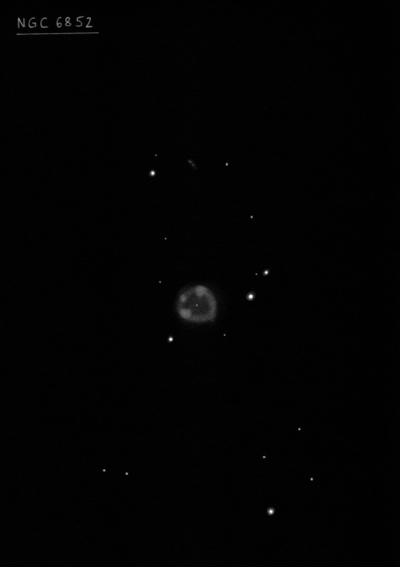
Albert Marth discovered NGC 6852 = m 404 on 25 Jun 1863 and noted "F neb, within a group of small stars." The same night he also discovered the planetary NGC 6778. Lubos Kohoutek rediscovered this object a century later during a visual survey of the POSS and included it in a list of new PN (K 1-18) published in 1963.
300/350mm - 13" (7/20/85): moderately bright, slightly elongated NW-SE, diffuse, no structure. Two stars are off NW edge about 40" and a faint star is at the SSE edge. Located 5' NE of a mag 8 star.
400/500mm - 17.5" (7/16/88): moderately bright, fairly small, slightly elongated NW-SE, no annularity noted. A mag 13.5 star is 34" WNW and a mag 14.5 star is 23" SE of center. Located 4.6' ENE of mag 7.5 SAO 125338. Estimate V = 12.5.
600/800mm - 24" (6/30/16): at 501x (unfiltered); very bright compact planetary, fairly small, slightly elongated ~N-S, ~25"x21". A darker center and bright knots in the rim give a bipolar annular appearance. A very small bright knot is at the southeast end, close to a mag 14.4 star that is just off the edge [22" from center]. A matching knot (slightly less contrasty) is along the northwest edge of the rim. A mag 13 field is less than 30" W of this knot. The rim is slightly weaker on the southwest and northeast sides (the south edge is not well defined), so in effect a darker strip or bar extends through the center in a SW-NE orientation, nearly slicing the planetary into two sections.
Notes by Steve Gottlieb
NGC 6738
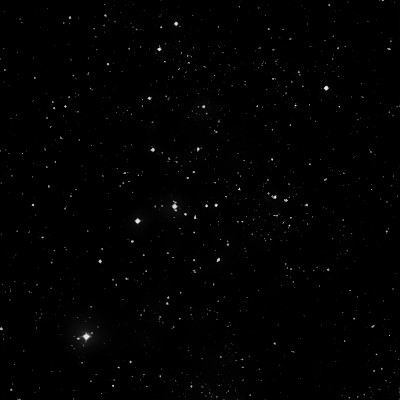
NGC 6738 is not a true cluster but an optical alignment of stars seen through various amounts of dust (see "NGC 6738: Not a real open cluster" in 2003A&A...406..893B).
John Herschel discovered NGC 6738 = h2027 on 29 Jul 1829 and noted "the central star (double) in a coarse and poor cluster." His position corresponds with HJ 1359, a wide unequal pair (9.1/12.6 at 18").
400/500mm - 17.5" (7/20/90): at 82x, 125 stars are visible. This cluster is bright and very large but scattered. Located between a mag 7.5 star and a mag 8 star with a 30' separation N-S. A nice string of fairly bright stars is between these two bright stars. Most of the cluster is west of this string but also a faint stream of stars is just following.
Notes by Steve Gottlieb
NGC 6790
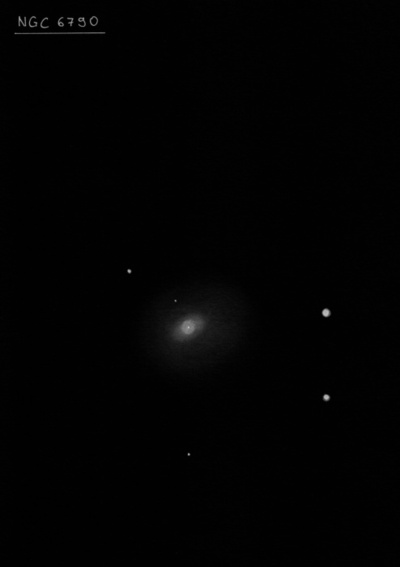
Edward Pickering discovered NGC 6790 on 16 Jul 1882 using a direct-vision spectroscope with the 15-inch refractor at Harvard College Observatory. He noted "very bright and minute." The discovery was announced in AN 2454 and The Observatory, Vol 5, for Oct 1882.
Based on Crossley photographs at Lick, Curtis (1918) reported "Indistinguishable from a star on the Crossley negatives, but shown to have a minute disk visually with the 36-inch refractor."
300/350mm - 13" (7/85): bright, just non-stellar 220x, estimate mag 10, easy blinker with OIII. A mag 11 star is 30" W. Forms the east vertex of a thin rhombus of mag 10 stars.
400/500mm - 17.5" (7/28/92): at 82x, very bright, stellar, surprisingly prominent, estimate V = 10.0. Blinks well with an OIII filter. At 280x appears very bright and a very small but definite disc about 5" diameter is visible with a bluish color. A mag 11.5 star lies 35" W.
Notes by Steve Gottlieb
NGC 6756
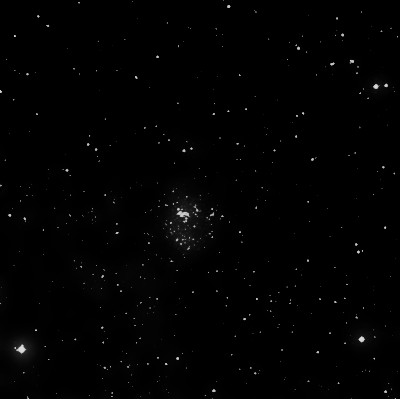
William Herschel discovered NGC 6756 = H VII-62 = h2031 on 21 Aug 1791 (sweep 1017) and recorded "a small pretty compressed cl. of stars, not very rich." JH made a total of 4 observations. On 13 Aug 1830 (sweep 278), he called it "pretty rich; S; m compressed; oval or rather fan-shaped. The stars 11...12m, 4' in extent; the nf side most compressed."
200/250mm - 8" (8/28/81): few faint stars at 100x over background haze.
400/500mm - 17.5" (7/27/92): at 280x, about two dozen mag 11.5 and fainter stars in a 6'x4' field surrounding a bright knot just east of center. A mag 13 star is at the NE edge of the knot. With concentration the central knot resolves into half a dozen very tightly packed mag 14 stars. The brightest mag 11.5 star in the cluster is 3' S of this knot. Set over unresolved background haze. Located 30' NE of open cluster NGC 6755.
Notes by Steve Gottlieb
NGC 6814
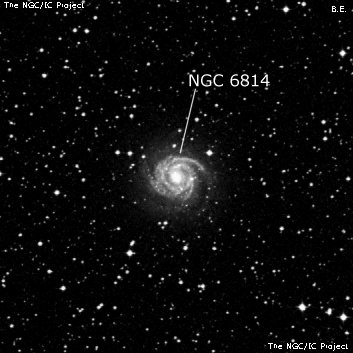
William Herschel discovered NGC 6814 = H III-744 = h2045 on 2 Aug 1788 (sweep 851) and noted "vF; pL; R; vgmbM." His position is accurate. JH made the single observation "Not vF; pL; R; bM; r; 50"."
200/250mm - 8" (8/15/82): faint, small, slightly brighter core, larger faint halo with averted.
300/350mm - 13.1" (7/20/85): this Seyfert galaxy appears fairly faint, round, 2.0' diameter, broad concentration, stellar nucleus, diffuse outer halo.
600/800mm - 24" (8/7/13): fairly bright, fairly large, round, ~1.5' diameter. Well concentrated with a bright core that increases to a very bright nucleus. A mag 13 star lies 1' NW and two mag 14/14.4 stars are a bit further northeast. Spiral structure is strongly suggested in the halo with an ill-defined segment of a curving arm on the east side and a counterpart on the west side. A very faint star (V = 15.6) is superimposed on the western arm.
Notes by Steve Gottlieb
NGC 6803
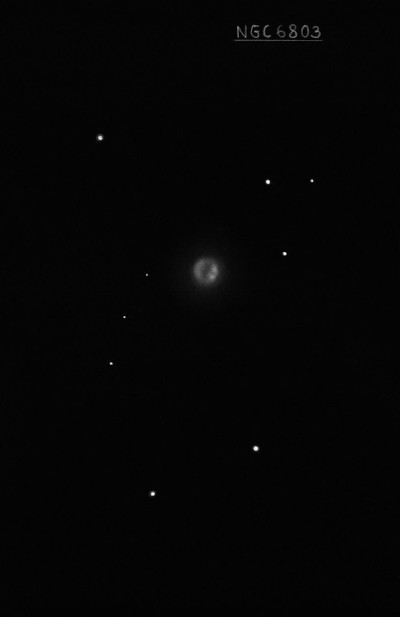
Edward Pickering discovered NGC 6803 = HN 52 on 17 Sep 1882 using a direct-vision prism attached to the 15-inch refractor at Harvard College Observatory. His position in Sidereal Messenger, Vol 1. No. 6 (Oct 1882) is accurate to within 1'.
Based on Crossley photographs at Lick, Curtis (1918) wrote, "a minute round disk, 5.5" in diameter, just distinguishable from a star; fades out a little at the edges."
200/250mm - 8" (8/5/83): appears slightly non-stellar at 385x. A similar field star is just 2' NW.
300/350mm - 13" fairly bright stellar planetary at 88x, good OIII blinker in a rich star field, estimate V = 11.5. Just non-stellar at 350x and about 3" diameter. A mag 11 star is 1.8' N.
400/500mm - 17.5" (9/5/99): picked up by blinking with an OIII filter at 100x as a mag 11.5 "star". At 220x, appears just non-stellar and is situated ~2' S of a mag 10.5-11 "comparison" star, which is a half magnitude brighter than the PN (unfiltered). Good response to blinking with a UHC filter. At 280x and 380x, the PN is very small but clearly nonstellar, <5" diameter with a blue-grayish color. Easily takes 500x but no other details were visible except for two mag 15 stars that are close west and northwest form a tiny equilateral triangle with the PN.
Notes by Steve Gottlieb
IC 4846
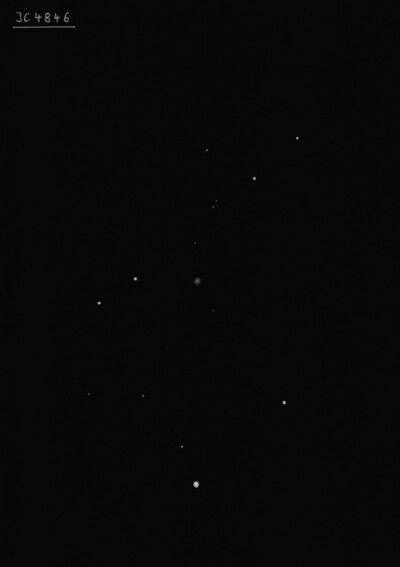
Williamina Fleming discovered IC 4846 = Fleming 100 on a Harvard photographic plate taken in 1901.
Based on Crossley photographs at Lick, Curtis (1918) reported "indistinguishable from a star on the Crossley negatives, but shown to have a minute disk visually in the 36-inch refractor."
300/350mm - 13.1" (7/85): bright stellar planetary, appears as a mag 11.5-12 "star" which blinks well with an OIII filter at 79x. Located in a rich star field 20' S of mag 7.3 SAO 143200.
600/800mm - 24" (9/10/15): bright greenish (stellar) planetary at 200x. The color gives it away but easily verified by blinking with an NPB filter. It clearly has a "soft" appearance at 260x and a very small disc is evident at 375x, just a couple of arcseconds in size. Forms the northwest vertex of a triangle with a mag 11 star 2.9' S and a similar star 3.6' ESE.
Notes by Steve Gottlieb
NGC 6807
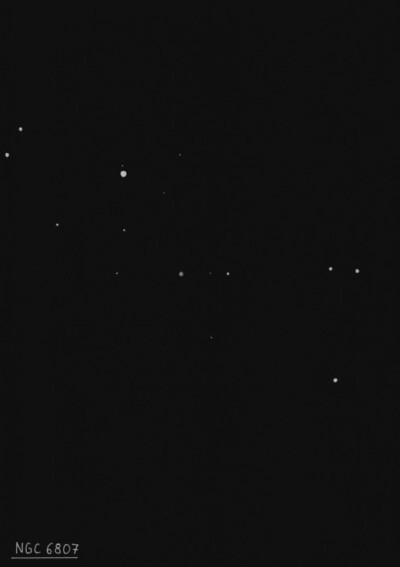
Edward Pickering discovered NGC 6807 = HN 51 on 4 Sep 1882 using a direct-vision spectroscope attached to the 15-inch Merz refractor at Harvard College Observatory. His position in Sidereal Messenger, Vol I, No 6 (Oct 1882) is ~30" too far north.
Based on Crossley photographs at Lick, Curtis (1918) wrote, "indistinguishable from a star on the Crossley negatives, but shown to have a minute disk visually with the 36-inch refractor."
400/500mm - 17.5" (7/20/90): at 140x appears as a mag 12 stellar object. Shows an excellent contrast gain with OIII filter. A brighter mag 10.5 comparison star 1.5' NE is similar to NGC 6807 with the OIII filter (so there is a two magnitudes contrast gain with the filter). Increasing the magnification to 286, it appeared to be quasi-stellar with a tiny disc surrounding the central star.
Notes by Steve Gottlieb
NGC 6785
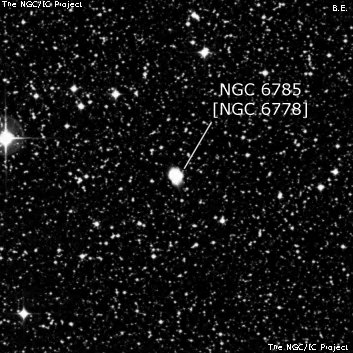
300/350mm - 13.1" (8/8/86): bright, fairly small, estimate V = 12.0-12.5. Very nice view at 214x with a UHC filter and slightly elongated WNW-ESE with a fainter rounder halo suspected.
400/500mm - 17.5" (9/5/99): fairly bright, but small disc picked up at 100x. Easily takes high power. Nice view unfiltered at 280x - the PN has an irregular surface brightness with a brighter center but no central star and appears slightly elongated WNW-ESE, perhaps 20"-25" in diameter. At 500x the outer edge of the rim fades and is not sharply defined. At moments a sparkle was visible at the center with this magnification. Located 5.0' WSW of mag 9 SAO 143251.
Notes by Steve Gottlieb
NGC 6926
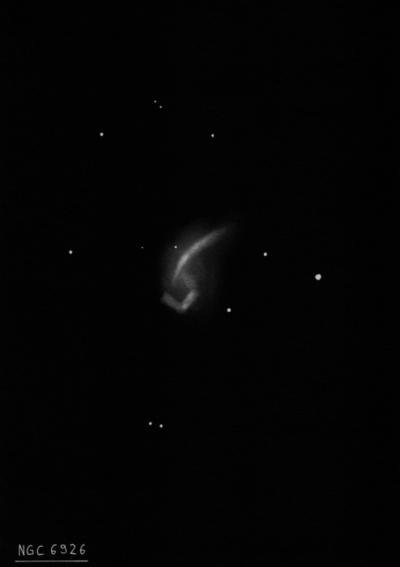
William Herschel discovered NGC 6926 = H III-142 = h2079 on 21 Jul 1784 (sweep 242) and recorded "vF, E, nearly of equal light throughout and about 2' long. A patch of not very close small stars north following." His RA was poor (too large), but clearly applies to UGC 11588. On 12 Sep 1830, John Herschel logged "vF; pL; pmE; or two joined; nearly in the meridian [N-S]." On JH's first observation three years earlier, he discovered nearby NGC 6929.
400/500mm - 17.5" (7/16/88): fairly faint, fairly large, elongated NNW-SSE, broad concentration. Brighter of pair with NGC 6929 3.9' E. Also brightest in a small group (USGC U788) that includes NGC 6922.
17.5" (8/1/86): moderately bright, fairly large, elongated, slightly brighter core.
Notes by Steve Gottlieb
Pal 11
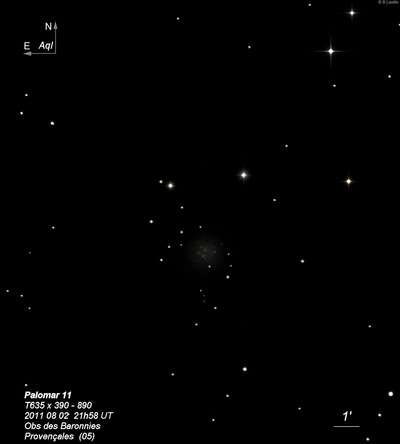
| Type | GC [XI] |
| RA | 19:45:18.0 |
| Dec | -08:01:00.0 |
| major_axis | 10.0' |
| mag | 9.8 |
| surface_bright | 14.6 |
Sh2-71
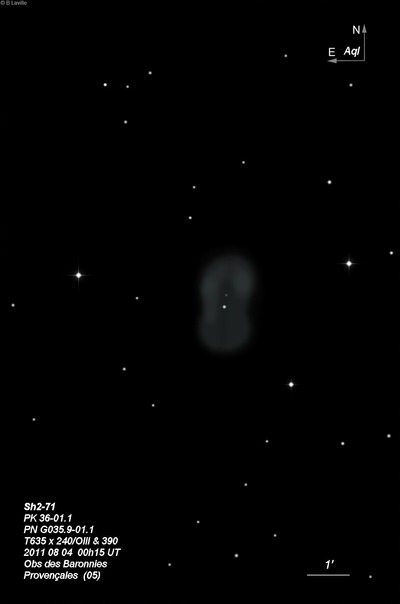
| Type | PN [3b(3)] |
| RA | 19:02:00.3 |
| Dec | +02:09:11.0 |
| major_axis | 4.0' |
| minor_axis | 2.0' |
| position_angle | 175.0 |
| mag | 12.3 |
| surface_bright | 13.4 |
Me 1-1
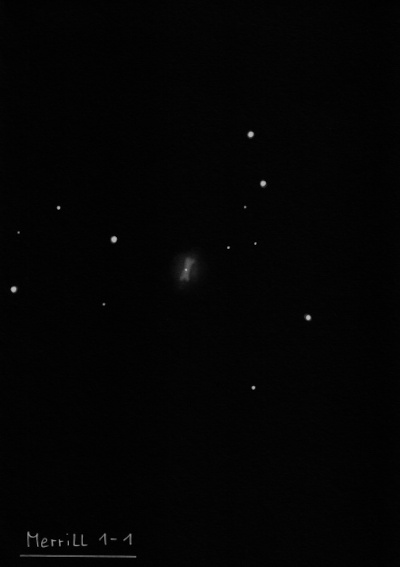
| Type | PN |
| RA | 19:39:09.8 |
| Dec | +15:56:48.0 |
| major_axis | 6.0'' |
| minor_axis | 18.0'' |
| mag | 12.6 |
| surface_bright | 7.9 |
M 1-73
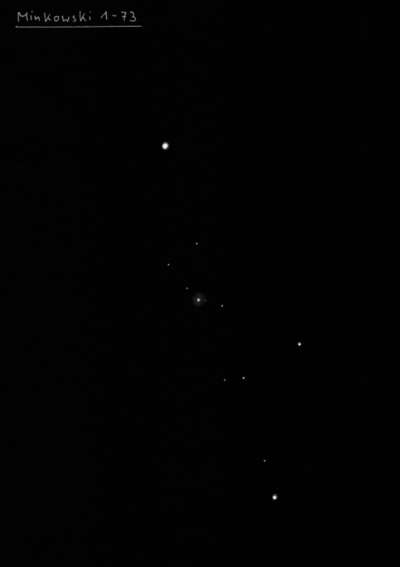
| Type | PN |
| RA | 19:41:09.3 |
| Dec | +14:56:59.0 |
| minor_axis | 54.0'' |
| mag | 13.7 |
| surface_bright | 8.1 |
Abell 70
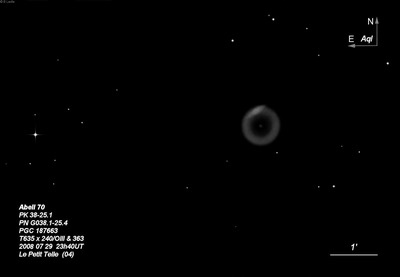
| Type | PN |
| RA | 20:31:33.2 |
| Dec | -07:05:18.0 |
| major_axis | 42.0'' |
| minor_axis | 42.0'' |
| mag | 14.3 |
| surface_bright | 13.3 |
Abell 62
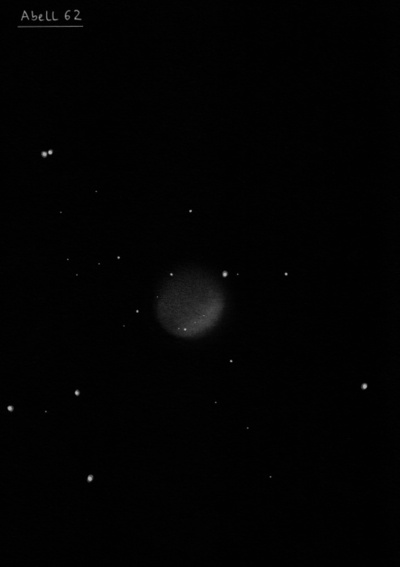
| Type | PN [2c] |
| RA | 19:33:17.7 |
| Dec | +10:37:04.0 |
| major_axis | 2.6' |
| mag | 14.8 |
| surface_bright | 16.6 |
PB 9
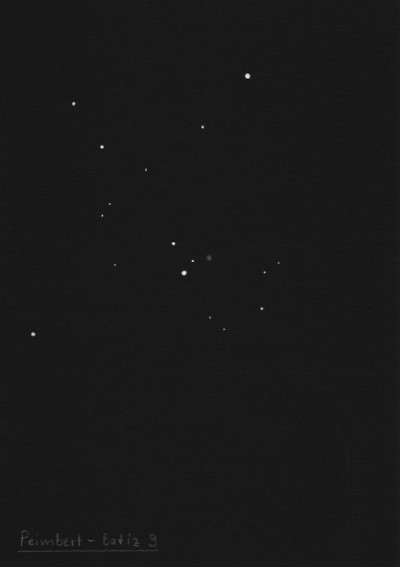
| Type | PN |
| RA | 19:27:44.8 |
| Dec | +10:24:21.0 |
| major_axis | 12.0'' |
| mag | 14.8 |
| surface_bright | 11.0 |
Abell 55
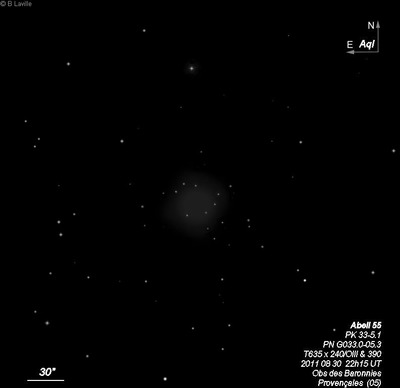
| Type | PN |
| RA | 19:10:25.8 |
| Dec | -02:20:23.0 |
| major_axis | 48.0'' |
| minor_axis | 30.0'' |
| mag | 15.4 |
| surface_bright | 14.2 |
Abell 56
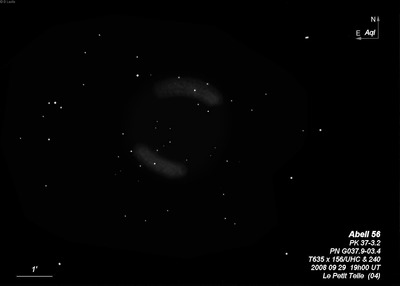
| Type | PN |
| RA | 19:13:06.1 |
| Dec | +02:52:48.0 |
| major_axis | 3.3' |
| minor_axis | 2.7' |
| mag | 15.5 |
| surface_bright | 17.6 |
Abell 67
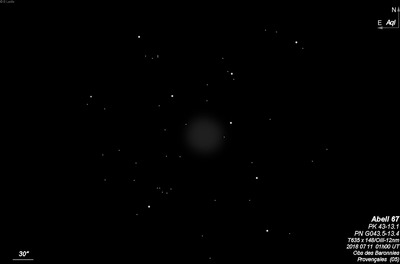
| Type | PN [2b] |
| RA | 19:58:27.0 |
| Dec | +03:03:00.0 |
| major_axis | 72.0'' |
| minor_axis | 60.0'' |
| mag | 16.0 |
| surface_bright | 15.9 |
Abell 52
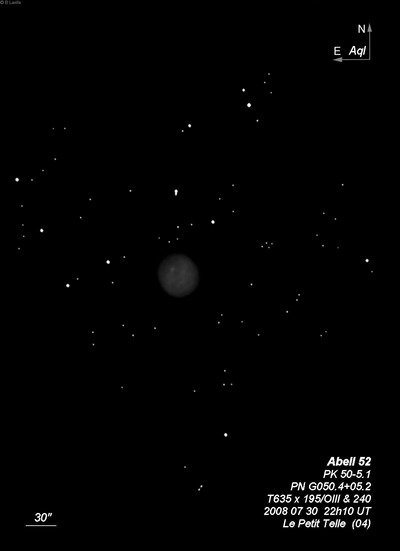
| Type | PN [3b] |
| RA | 19:04:32.3 |
| Dec | +17:57:07.0 |
| major_axis | 36.0'' |
| minor_axis | 36.0'' |
| mag | 16.5 |
| surface_bright | 15.1 |
Abell 53
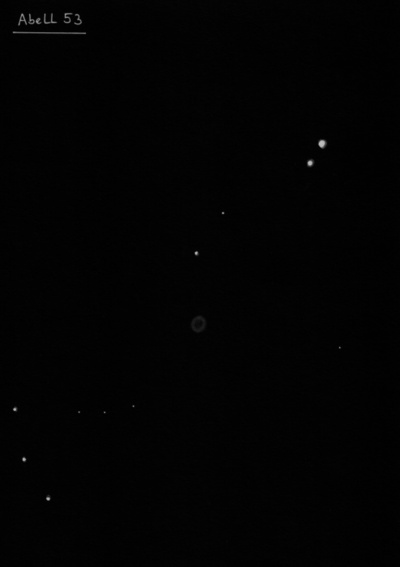
| Type | PN |
| RA | 19:06:45.9 |
| Dec | +06:23:52.0 |
| major_axis | 30.0'' |
| minor_axis | 30.0'' |
| mag | 16.9 |
| surface_bright | 15.0 |
Abell 48
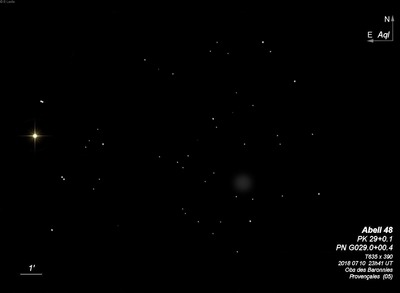
| Type | PN |
| RA | 18:42:46.9 |
| Dec | -03:13:17.0 |
| major_axis | 42.0'' |
| mag | 18.7 |
| surface_bright | 17.7 |
Abell 58
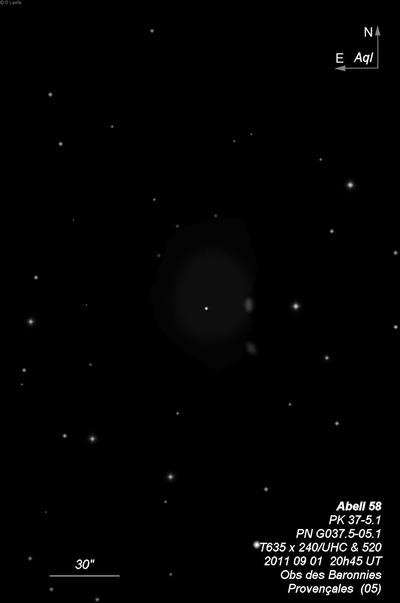
| Type | PN |
| RA | 19:18:20.5 |
| Dec | +01:47:00.0 |
| major_axis | 42.0'' |
| minor_axis | 36.0'' |
| mag | 18.8 |
| surface_bright | 17.6 |
